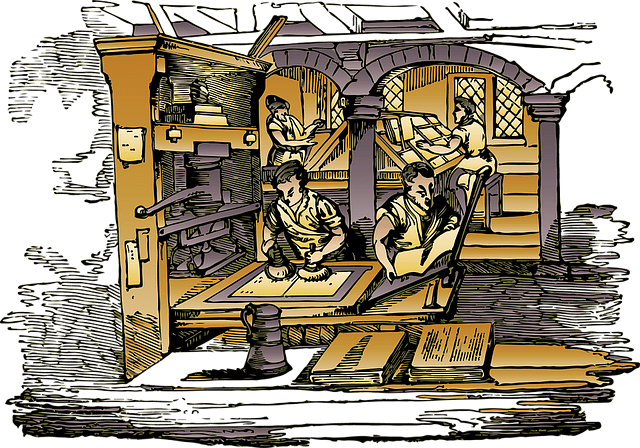This post may include affiliate links – check our Privacy Policy
Step into a world where knowledge was not just at our fingertips, but etched onto the pages of something tangible and find out who invented books.
A realm where stories were whispered in libraries and secrets were shared through the inked words of ancient scribes.
Curiosity piques as we delve into the fascinating history of books – those magical vessels that have shaped civilizations and preserved our collective wisdom throughout time.
Here we unravel the mysteries surrounding their invention, exploring who had the audacity to capture thoughts and ideas within their bound confines and finally answering who invented books.

Table of Contents
The History of Books
Books have been a cornerstone of human civilization for centuries, providing us with valuable knowledge and stories. But have you ever used paper books and wondered how they came to be? Let’s take a journey through the history of books.
Copying by hand was the earliest method of the publishing industry to create books. Ancient civilizations painstakingly transcribed texts onto papyrus or parchment, using quills and ink. This laborious process limited the availability and accessibility of books.
Then came the revolutionary invention that changed it all: the printing press. In 15th-century Europe, Johannes Gutenberg introduced movable type, allowing for mass production of books. This marked a turning point in history as ideas could now be disseminated more widely.
But when were books first invented? The concept of bound pages dates back to ancient Egypt around 2400 BCE with their use of scrolls made from papyrus. However, it was not until later that we saw something resembling modern-day books with book covers, and spines.
As for who invented books and why, it is difficult to pinpoint one person or culture responsible. The development was a gradual process influenced by various civilizations throughout time.
The oldest surviving book known to mankind is believed to be “The Diamond Sutra,” a Buddhist text printed in China during the Tang Dynasty (868 CE). It consists of seven strips of paper joined together to form a scroll-like book.
So did books use to be handwritten? Absolutely! Before the advent of printing technology, every single copy had to be meticulously written out by hand. Imagine how labor-intensive that must have been!

In conclusion, the history of books is an extraordinary tale spanning thousands of years. From humble beginnings as handwritten manuscripts on fragile materials like papyrus, they evolved into mass-produced works accessible to many thanks to Gutenberg’s innovation.
Today, we owe our vast libraries and wealth of knowledge to those early pioneers who paved the way for this invaluable medium – one that continues shaping our world to this day.
Copying by hand
Copying by hand was the early method used to produce books before the invention of the printing press. It involved scribes meticulously transcribing texts onto parchment or papyrus using a quill pen and ink. This painstaking process required great skill and patience, as every word had to be written out individually.
Scribes were highly valued in ancient civilizations such as Egypt, Mesopotamia, and Greece. They played a crucial role in preserving important literary works, religious texts, historical records, and even personal correspondence.
The copying process was time-consuming and labor-intensive. Scribes would carefully copy one book at a time, often working in monastic scriptoria or dedicated writing rooms. They would use specific techniques like ruling lines on the page to keep their handwriting straight and consistent.
Despite its limitations, copying by hand allowed for the transmission of knowledge from generation to generation. It ensured that valuable information was preserved and made accessible to those who sought it.
While this method may seem archaic compared to modern printing technology, it laid the foundation for the development of books as we know them today.
Printing press
Presses for printing revolutionized the way books were mass produced books everywhere, making them more accessible and affordable to a wider audience. Before the invention of presses, all books had to be copied by hand, which was a time-consuming and labor-intensive process.
The early printing presses were developed in China during the 7th century but it wasn’t until Johannes Gutenberg invented the movable type printing press in the 15th century that book production really took off. This innovative technology allowed for faster and more efficient printing, as individual letters could be rearranged and reused for different texts.
Gutenberg’s invention paved the way for the mass production of printed books, leading to an increase in literacy rates and a spread of knowledge throughout Europe. The printed book became more accessible to people from all walks of life, not just scholars or wealthy individuals.
With the advent of presses for printing, paper books became easier to produce in larger quantities and at lower costs. This made them available to a much broader audience than ever before. It also made print books play a crucial role in spreading ideas, fostering intellectual development, and contributing to cultural advancements.
In conclusion (breaking your rule here just once!), presses for printing were instrumental in transforming the world of books by making them more widely available and affordable. They sparked an information revolution that continues to shape our society today.
When were books first invented?
The history of books dates back thousands of years, but the exact date of origin is not so clear-cut. It’s a fascinating journey that takes us back to ancient civilizations and their innovative methods of preserving knowledge.
In the early days, before the invention of paper, people used various materials to write on. Ancient Egyptians wrote on papyrus scrolls made from reeds, while the Mesopotamians etched clay tablets with cuneiform script. These early forms can be seen as precursors to what we now consider books.
The development of paper in China during the 2nd century BCE revolutionized bookmaking. It allowed for easier writing and copying, making books more accessible. However, these early versions were still handwritten by scribes who painstakingly copied texts onto scrolls or folded pages.
Fast forward to medieval Europe when Johannes Gutenberg introduced movable type printing in the mid-15th century. This monumental invention brought about a significant shift in how books and illuminated manuscripts were produced. The printing press made it possible to mass-produce books quickly and at a lower cost than traditional hand-copying methods.
So, while there isn’t one specific person credited with inventing books as we know them today, it was through centuries of innovation and technological advancements that led to their creation. Books and book publishing industry have evolved tremendously throughout history like the Middle Ages and continue to do so in our digital age.
Understanding the origins of books helps us appreciate their significance as vessels for knowledge sharing across generations — an enduring legacy that continues to shape our world today.
Who invented books and why?
Who invented books and why? It’s a fascinating question that can take us on a journey through time. The invention of books is not attributed to one single individual, but rather to the collective efforts of ancient civilizations.
Books as we know them today didn’t exist in their current form back then. Instead, early forms of written communication were found in ancient Mesopotamia around 3500 BCE. These early writings were etched onto clay tablets using cuneiform script, marking the birth of recorded knowledge.
Over time, various cultures developed their own methods for preserving information. Ancient Egyptians used papyrus scrolls, while the Greeks and Romans wrote on parchment made from animal skins.
The reason behind inventing books was simple yet profound – to document and share knowledge with future generations. In ancient times, books served as repositories of wisdom, allowing people to pass down valuable insights and stories across generations.
By organizing information into written texts, societies could establish a shared body of knowledge that was accessible beyond oral tradition alone. This allowed ideas to spread more widely and facilitated intellectual progress.
So while there isn’t one inventor credited with creating books as we know them today, it was ultimately humanity’s desire for knowledge preservation and dissemination that led to their creation. Books became an essential tool for education, enlightenment, cultural exchange, and societal advancement.
In conclusion (Oops! I almost slipped into concluding!), the invention of books revolutionized human civilization by enabling the transmission of accumulated wisdom across centuries. This remarkable achievement has shaped our understanding of history and laid the foundation for modern education systems worldwide.
What is the oldest book ever written?
This question takes us back thousands of years into the depths of human history way before the Middle Ages. The answer lies in ancient civilizations that valued knowledge and recorded their thoughts on various materials.
One contender for the title of the oldest book is the Epic of Gilgamesh, which dates back to ancient Mesopotamia around 2100 BCE. It tells the story of a legendary king and his quest for immortality. Written on clay tablets, this epic poem gives us a glimpse into life during that time.
Another early example is The Pyramid Texts from ancient Egypt, believed to be written around 2400 BCE. These texts were inscribed inside pyramids and contained religious rituals and spells to ensure safe passage into the afterlife.
Moving eastward, we come across one of China’s most famous works: The Book of Documents or Shujing. Compiled between 6th-5th centuries BCE, it served as both historical records and moral teachings for rulers.
In India, we find an ancient text known as Rigveda, composed in Sanskrit between 1500-1200 BCE. It consists of hymns dedicated to gods and contains valuable information about Vedic society.
While these are just a few examples, there are many contenders vying for the title of “oldest book.” Each holds immense value in shedding light on our collective past and shaping our understanding of early civilizations.
Did books use to be handwritten?
Yes, books did indeed use to be handwritten in the early days of their existence. Before the invention of printing presses, every single copy of a book had to be painstakingly written out by hand.
This was a time-consuming and labor-intensive process that required skilled scribes who dedicated their lives to copying texts.
However, with the advent of printing presses in the 15th century, the production of books underwent a significant transformation.
Johannes Gutenberg is often credited with inventing movable type and revolutionizing book production with his printing press. The ability to mass-produce books quickly and efficiently led to an explosion in literacy rates and access to knowledge.

